check engine BMW ACTIVE HYBRID 7 2013 F04 Owner's Guide
[x] Cancel search | Manufacturer: BMW, Model Year: 2013, Model line: ACTIVE HYBRID 7, Model: BMW ACTIVE HYBRID 7 2013 F04Pages: 253, PDF Size: 5.01 MB
Page 216 of 253

MaintenanceVehicle equipment
All standard, country-specific and optional
equipment that is offered in the model series is
described in this chapter. Therefore, equip‐
ment is also described that is not available in a
vehicle, e. g., because of the selected optional
equipment or country variant. This also applies
for safety-related functions and systems.
BMW Maintenance System The maintenance system directs you to re‐
quired maintenance measures and thereby
supports you in maintaining road safety and
the operational reliability of the vehicle.
Condition Based Service
CBS
Sensors and special algorithms take into ac‐
count the driving conditions of your vehicle.
Based on this, Condition Based Service deter‐
mines the maintenance requirements.
The system makes it possible to adapt the
amount of maintenance you need to your user
profile.
Details on the service requirements, refer to
page 90, can be displayed on the Control Dis‐
play.
Service data in the remote control
Information on the required maintenance is
continuously stored in the remote control.
Your service center will read out this data and
suggest the right array of service procedures
for your vehicle.
Therefore, hand your service specialist the re‐
mote control with which the vehicle was driven
most recently.Storage periods
Storage periods during which the vehicle bat‐
tery was disconnected are not taken into ac‐
count.
If this occurs, have a service center update the
time-dependent maintenance procedures,
such as checking brake fluid and, if necessary,
changing the engine oil and the microfilter/
activated-charcoal filter.
Service history Perform maintenance work at the service cen‐
ter and have them recorded in the vehicle data.
The entries are like a service booklet of the
documentation of regular maintenance.
Displaying entered maintenance work on the
Control Display, refer to page 91.
Service and Warranty
Information Booklet for US
models and Warranty and
Service Guide Booklet for
Canadian models
Please consult your Service and Warranty In‐
formation Booklet for US models and Warranty
and Service Guide Booklet for Canadian mod‐
els for additional information on service re‐
quirements.
Maintenance and repair should be performed
by your service center. Make sure to have reg‐
ular maintenance procedures recorded in the
vehicle's Service and Warranty Information
Booklet for US models, and in the Warranty
and Service Guide Booklet for Canadian mod‐
els. These entries are proof of regular mainte‐
nance.Seite 212MobilityMaintenance212
Online Edition for Part no. 01 40 2 909 774 - VI/13
Page 217 of 253
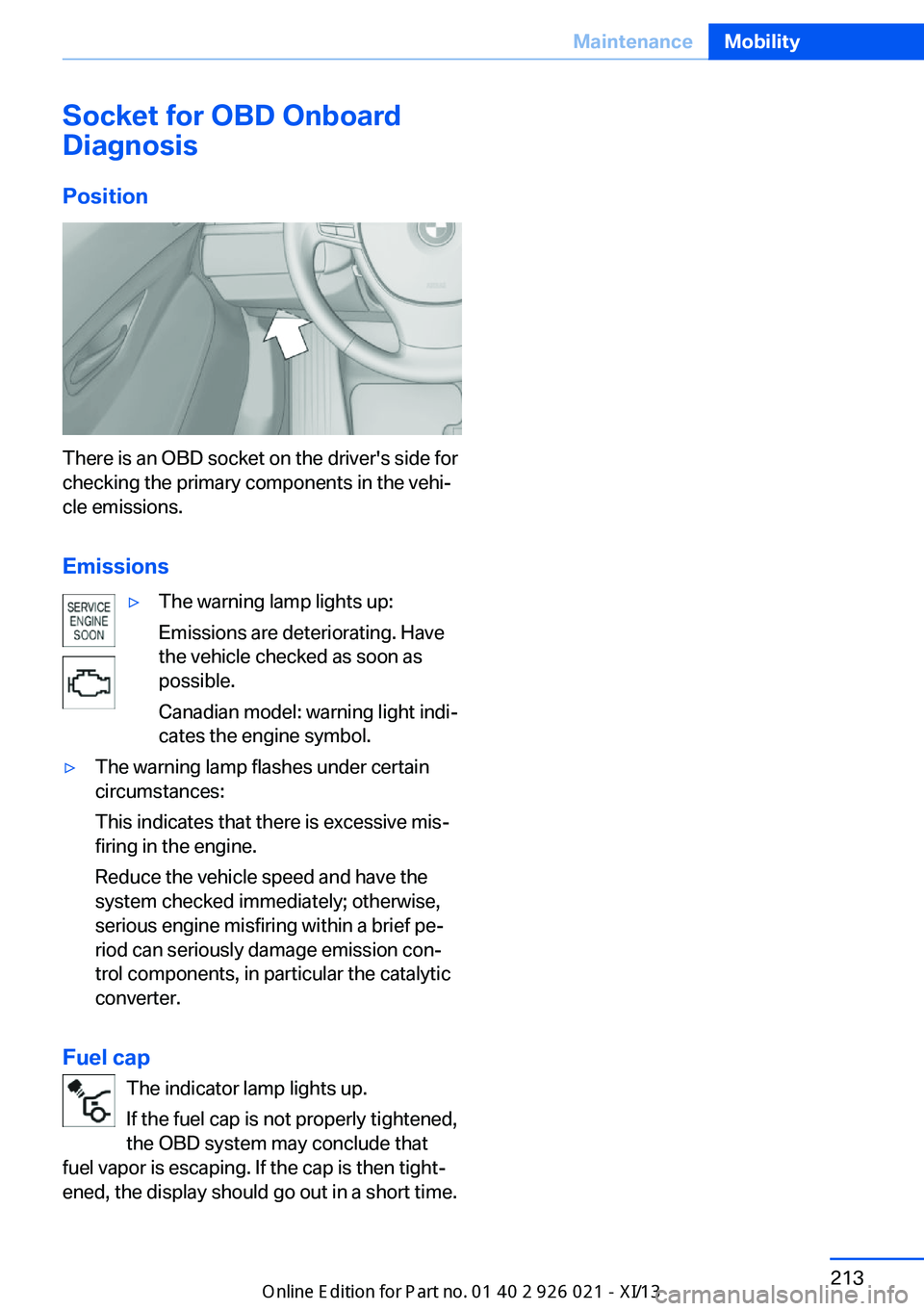
Socket for OBD Onboard
Diagnosis
Position
There is an OBD socket on the driver's side for
checking the primary components in the vehi‐
cle emissions.
Emissions
▷The warning lamp lights up:
Emissions are deteriorating. Have
the vehicle checked as soon as
possible.
Canadian model: warning light indi‐
cates the engine symbol.▷The warning lamp flashes under certain
circumstances:
This indicates that there is excessive mis‐
firing in the engine.
Reduce the vehicle speed and have the
system checked immediately; otherwise,
serious engine misfiring within a brief pe‐
riod can seriously damage emission con‐
trol components, in particular the catalytic
converter.
Fuel cap
The indicator lamp lights up.
If the fuel cap is not properly tightened,
the OBD system may conclude that
fuel vapor is escaping. If the cap is then tight‐
ened, the display should go out in a short time.
Seite 213MaintenanceMobility213
Online Edition for Part no. 01 40 2 909 774 - VI/13
Page 220 of 253

If a bulb fails, switch on the front fog lamps and
continue the trip with great care. Comply with
local regulations.
Do not perform work/bulb replacement
on xenon headlamps
Have any work on the xenon lighting system,
including bulb replacement, performed only by
a service center. Due to the high voltage
present in the system, there is the danger of
fatal injuries if work is carried out improperly.◀
For checking and adjusting headlamp aim,
please contact your BMW center.
Light-emitting diodes (LEDs)
Follow the general instructions on Lamps and
bulbs, refer to page 214.
With Xenon-headlamps, the following lamps
are designed with LED technology:▷Parking lamps and roadside parking lamps.▷Turn signals, incl. side indicators▷Daytime running lights
Contact your service center in the event of a
malfunction.
Turning lamp with the Xenon
headlamp
Follow the general instructions on lamps and
bulbs, refer to page 214.
The illustration shows the left side of the en‐ gine compartment.
55-watt bulb, H7.1.Open the folding cover in the engine com‐
partment.2.Turn the cap and remove it.3.Pull the connector off the bulb.4.Squeeze the wire bracket together and de‐
tach.5.Remove the bulb and replace it.6.Insert the new bulb and attach the cover in
the reverse order.Seite 216MobilityReplacing components216
Online Edition for Part no. 01 40 2 909 774 - VI/13
Page 223 of 253
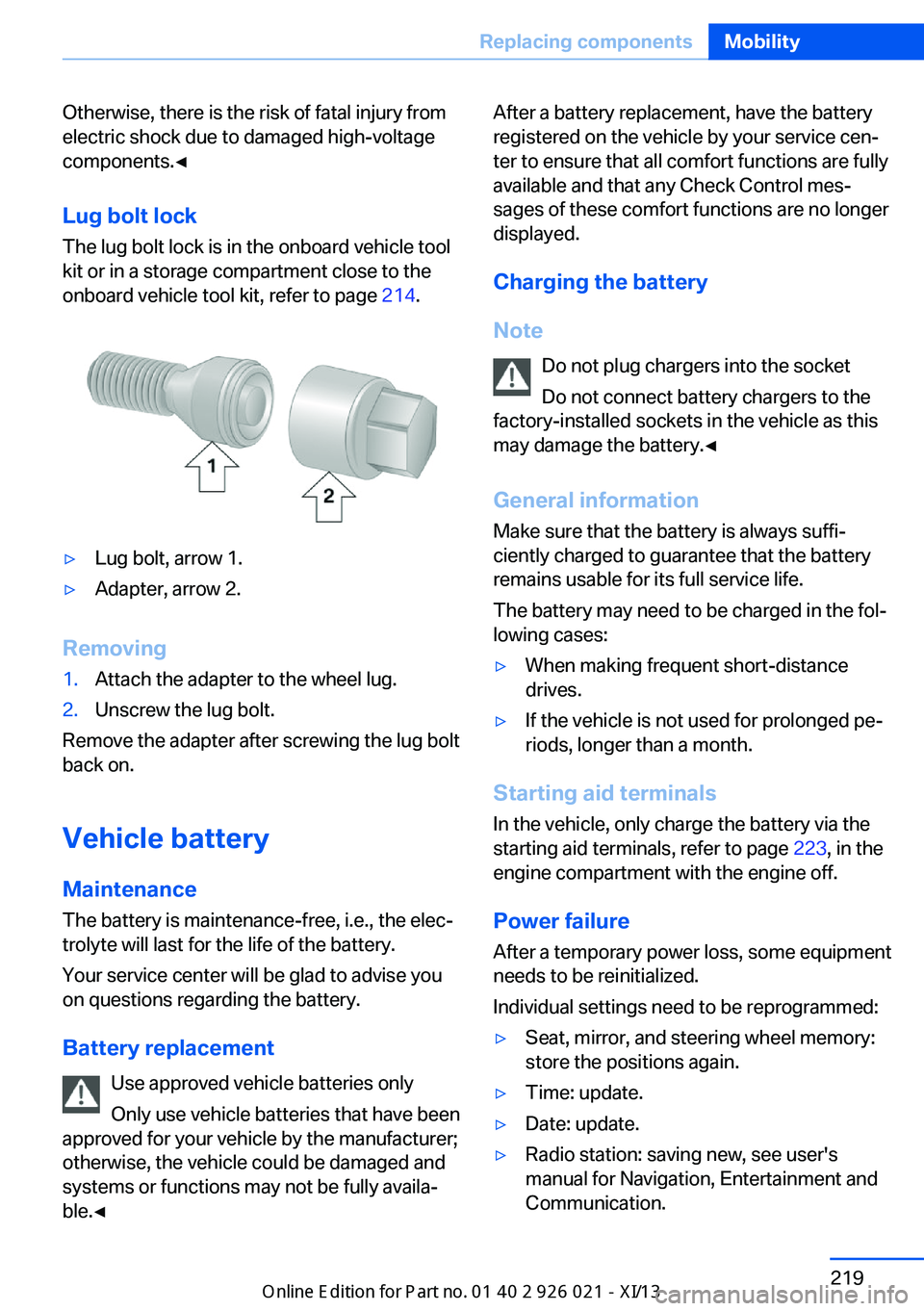
Otherwise, there is the risk of fatal injury from
electric shock due to damaged high-voltage
components.◀
Lug bolt lock
The lug bolt lock is in the onboard vehicle tool
kit or in a storage compartment close to the
onboard vehicle tool kit, refer to page 214.▷Lug bolt, arrow 1.▷Adapter, arrow 2.
Removing
1.Attach the adapter to the wheel lug.2.Unscrew the lug bolt.
Remove the adapter after screwing the lug bolt
back on.
Vehicle battery
Maintenance
The battery is maintenance-free, i.e., the elec‐
trolyte will last for the life of the battery.
Your service center will be glad to advise you
on questions regarding the battery.
Battery replacement Use approved vehicle batteries only
Only use vehicle batteries that have been
approved for your vehicle by the manufacturer;
otherwise, the vehicle could be damaged and
systems or functions may not be fully availa‐
ble.◀
After a battery replacement, have the battery
registered on the vehicle by your service cen‐
ter to ensure that all comfort functions are fully
available and that any Check Control mes‐
sages of these comfort functions are no longer
displayed.
Charging the battery
Note Do not plug chargers into the socketDo not connect battery chargers to the
factory-installed sockets in the vehicle as this
may damage the battery.◀
General information Make sure that the battery is always suffi‐
ciently charged to guarantee that the battery
remains usable for its full service life.
The battery may need to be charged in the fol‐
lowing cases:▷When making frequent short-distance
drives.▷If the vehicle is not used for prolonged pe‐
riods, longer than a month.
Starting aid terminals
In the vehicle, only charge the battery via the
starting aid terminals, refer to page 223, in the
engine compartment with the engine off.
Power failure After a temporary power loss, some equipment
needs to be reinitialized.
Individual settings need to be reprogrammed:
▷Seat, mirror, and steering wheel memory:
store the positions again.▷Time: update.▷Date: update.▷Radio station: saving new, see user's
manual for Navigation, Entertainment and
Communication.Seite 219Replacing componentsMobility219
Online Edition for Part no. 01 40 2 909 774 - VI/13
Page 226 of 253

if it can be established, are transmitted to
the BMW Response Center.▷If the LED is flashing, but the BMW Re‐
sponse Center can no longer be heard via
the speaker, you can nevertheless still be
heard for the BMW Response Center.
Initiating an Emergency Request
automatically
Under certain conditions, an Emergency Re‐
quest is automatically initiated immediately af‐
ter a severe accident. Automatic Collision Noti‐
fication is not affected by pressing the SOS
button.
Warning triangle
The warning triangle is located in the container
on the inside of the trunk lid.
Unscrew the wing nut to open.
First aid kit
Note Some of the articles have a limited service life.
Check the expiration dates of the contents
regularly and replace any expired items
promptly.
Storage
The first aid kit is located in the container on
the inside of the trunk lid.
Unscrew the wing nut to open.
Roadside Assistance
Service availability
Roadside Assistance can be reached around
the clock in many countries. You can obtain as‐
sistance there in the event of a vehicle break‐
down.
Roadside Assistance The Roadside Assistance phone number can
be viewed on the iDrive or a connection to
Roadside Assistance can be established di‐
rectly.
Jump-starting
Notes If the battery is discharged, an engine can be
started using the battery of another vehicle
and two jumper cables. Only use jumper ca‐
bles with fully insulated clamp handles.
To prevent personal injury or damage to both
vehicles, adhere strictly to the following proce‐
dure.
Seite 222MobilityBreakdown assistance222
Online Edition for Part no. 01 40 2 909 774 - VI/13
Page 227 of 253
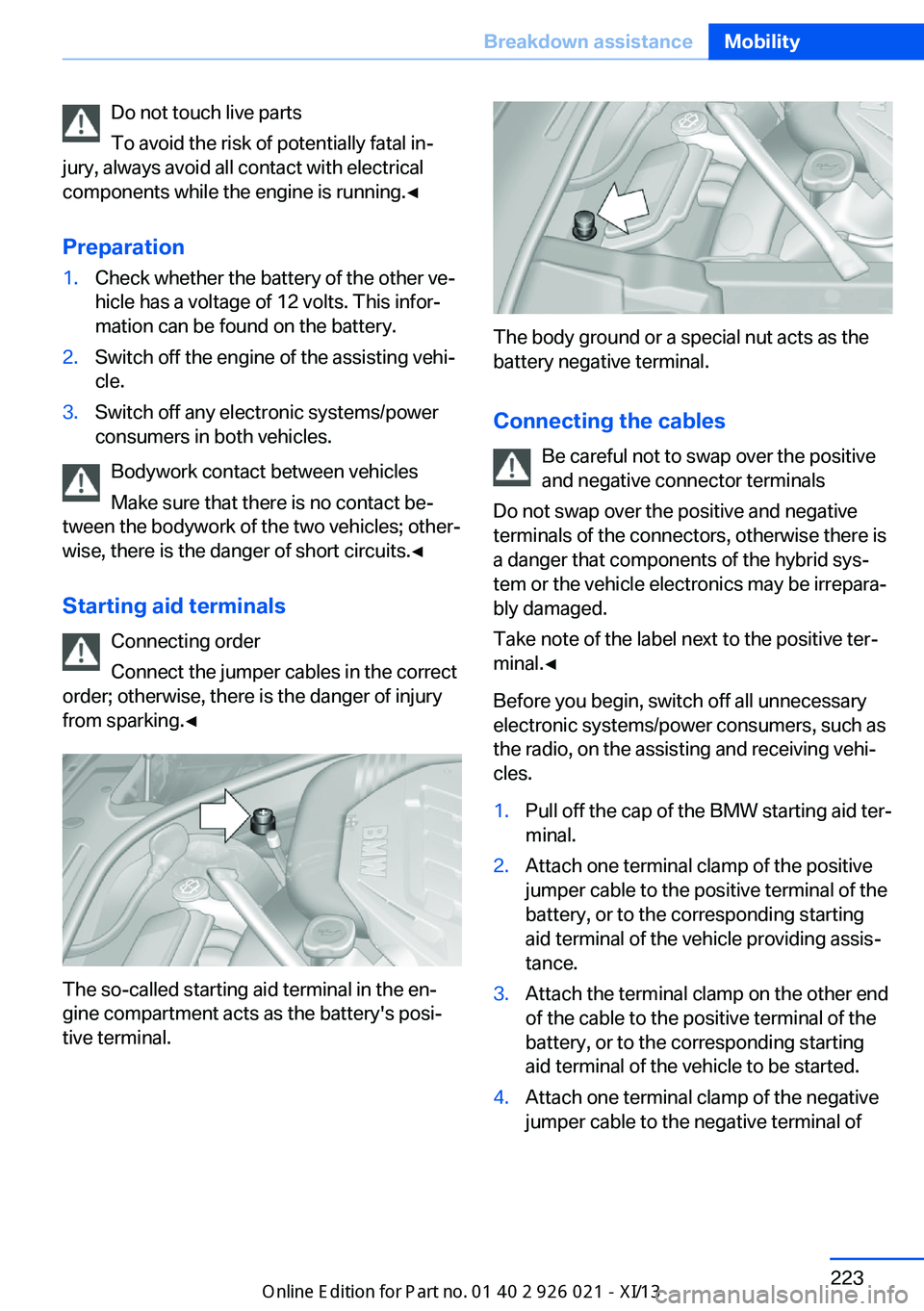
Do not touch live parts
To avoid the risk of potentially fatal in‐
jury, always avoid all contact with electrical
components while the engine is running.◀
Preparation1.Check whether the battery of the other ve‐
hicle has a voltage of 12 volts. This infor‐
mation can be found on the battery.2.Switch off the engine of the assisting vehi‐
cle.3.Switch off any electronic systems/power
consumers in both vehicles.
Bodywork contact between vehicles
Make sure that there is no contact be‐
tween the bodywork of the two vehicles; other‐
wise, there is the danger of short circuits.◀
Starting aid terminals Connecting order
Connect the jumper cables in the correct
order; otherwise, there is the danger of injury
from sparking.◀
The so-called starting aid terminal in the en‐
gine compartment acts as the battery's posi‐
tive terminal.
The body ground or a special nut acts as the
battery negative terminal.
Connecting the cables Be careful not to swap over the positive
and negative connector terminals
Do not swap over the positive and negative
terminals of the connectors, otherwise there is
a danger that components of the hybrid sys‐
tem or the vehicle electronics may be irrepara‐
bly damaged.
Take note of the label next to the positive ter‐
minal.◀
Before you begin, switch off all unnecessary
electronic systems/power consumers, such as
the radio, on the assisting and receiving vehi‐
cles.
1.Pull off the cap of the BMW starting aid ter‐
minal.2.Attach one terminal clamp of the positive
jumper cable to the positive terminal of the
battery, or to the corresponding starting
aid terminal of the vehicle providing assis‐
tance.3.Attach the terminal clamp on the other end
of the cable to the positive terminal of the
battery, or to the corresponding starting
aid terminal of the vehicle to be started.4.Attach one terminal clamp of the negative
jumper cable to the negative terminal ofSeite 223Breakdown assistanceMobility223
Online Edition for Part no. 01 40 2 909 774 - VI/13
Page 228 of 253
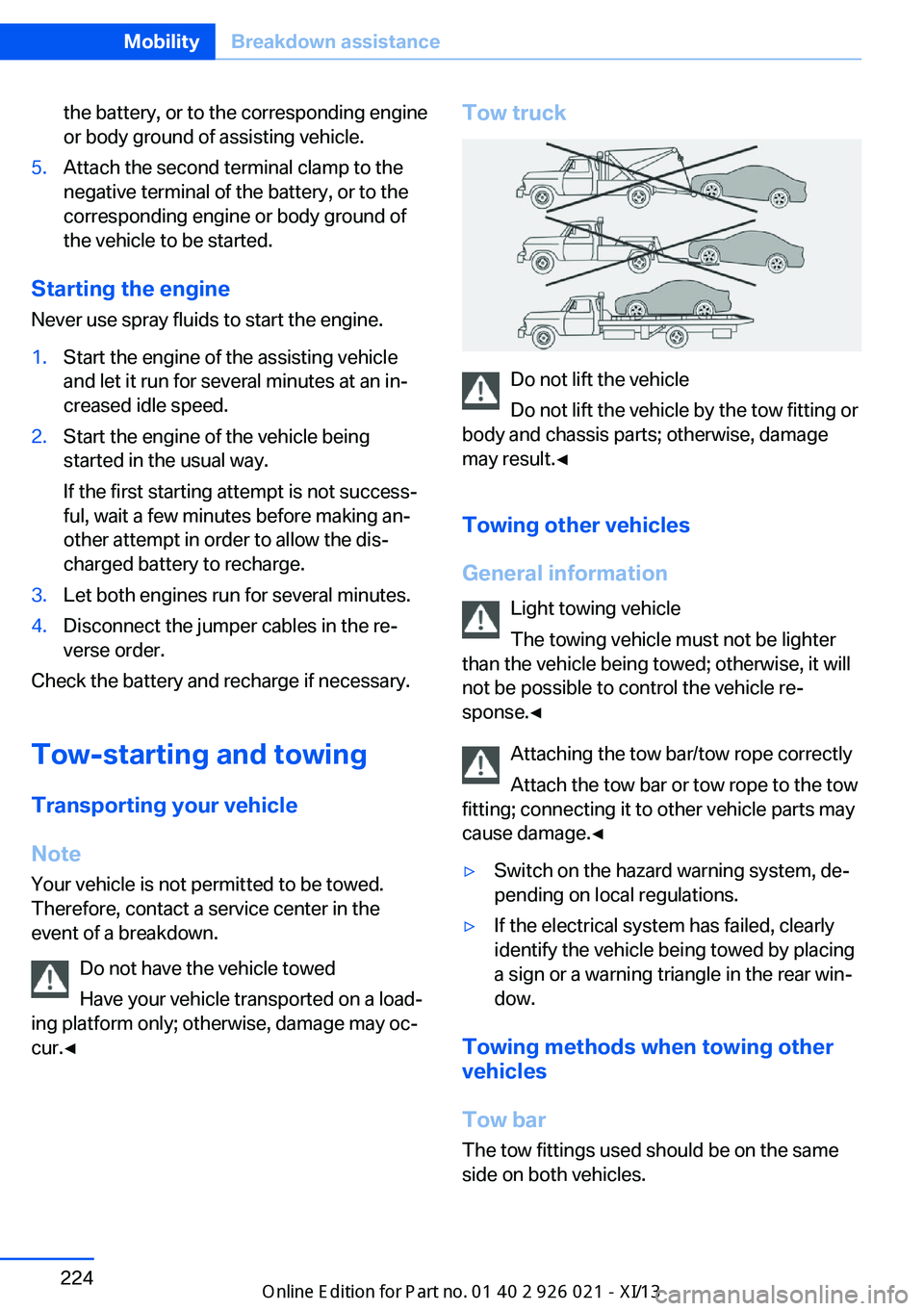
the battery, or to the corresponding engine
or body ground of assisting vehicle.5.Attach the second terminal clamp to the
negative terminal of the battery, or to the
corresponding engine or body ground of
the vehicle to be started.
Starting the engine
Never use spray fluids to start the engine.
1.Start the engine of the assisting vehicle
and let it run for several minutes at an in‐
creased idle speed.2.Start the engine of the vehicle being
started in the usual way.
If the first starting attempt is not success‐
ful, wait a few minutes before making an‐
other attempt in order to allow the dis‐
charged battery to recharge.3.Let both engines run for several minutes.4.Disconnect the jumper cables in the re‐
verse order.
Check the battery and recharge if necessary.
Tow-starting and towing Transporting your vehicle
Note
Your vehicle is not permitted to be towed.
Therefore, contact a service center in the
event of a breakdown.
Do not have the vehicle towed
Have your vehicle transported on a load‐
ing platform only; otherwise, damage may oc‐
cur.◀
Tow truck
Do not lift the vehicle
Do not lift the vehicle by the tow fitting or
body and chassis parts; otherwise, damage
may result.◀
Towing other vehicles
General information Light towing vehicle
The towing vehicle must not be lighter
than the vehicle being towed; otherwise, it will
not be possible to control the vehicle re‐
sponse.◀
Attaching the tow bar/tow rope correctly
Attach the tow bar or tow rope to the tow
fitting; connecting it to other vehicle parts may
cause damage.◀
▷Switch on the hazard warning system, de‐
pending on local regulations.▷If the electrical system has failed, clearly
identify the vehicle being towed by placing
a sign or a warning triangle in the rear win‐
dow.
Towing methods when towing other
vehicles
Tow bar The tow fittings used should be on the same
side on both vehicles.
Seite 224MobilityBreakdown assistance224
Online Edition for Part no. 01 40 2 909 774 - VI/13
Page 231 of 253

CareVehicle equipmentAll standard, country-specific and optional
equipment that is offered in the model series is
described in this chapter. Therefore, equip‐
ment is also described that is not available in a
vehicle, e. g., because of the selected optional
equipment or country variant. This also applies
for safety-related functions and systems.
Car washes Hints Steam jets or high-pressure washers
When using steam jets or high-pressure
washers, hold them a sufficient distance away and use a maximum temperature of
140 ℉/60 ℃.
If the vehicle has a glass sunroof, ensure that a distance of at least 31.5 inches/80 cm is main‐
tained. Holding them too close or using exces‐
sively high pressures or temperatures can
cause damage or preliminary damage that may
then lead to long-term damage.
Follow the user's manual for the high-pressure
washer.◀
Cleaning sensors/cameras with high-
pressure washers
When using high-pressure washers, do not
spray the exterior sensors and cameras, e.g., Park Distance Control, for extended periods of
time and only from a distance of at least
12 in/30 cm.◀
Regularly remove foreign items such as leaves
in the area below the windshield when the
hood is raised.
Wash your vehicle frequently, particularly in
winter.Intense soiling and road salt can damage the
vehicle.
Automatic car washes
Hints
Note the following:▷Give preference to cloth car washes or
those that use soft brushes in order to
avoid paint damage.▷Make sure that the wheels and tires are not
damaged by the transport mechanisms.▷Fold in the exterior mirrors; otherwise, they
may be damaged, depending on the width
of the vehicle.▷Deactivate the rain sensor, refer to
page 80, to avoid unintentional wiper acti‐
vation.▷In some cases, an unintentional alarm can
be triggered by the interior motion sensor
of the alarm system. Follow the instruc‐
tions on avoiding an unintentional alarm,
refer to page 47.
Guide rails in car washes
Avoid car washes with guide rails higher
than 4 in/10 cm; otherwise, the vehicle body
could be damaged.◀
Before driving into a car wash In order to ensure that the vehicle can roll in a
car wash, take the following steps:
1.Drive into the car wash.2.Engage transmission position N.3.Switch the engine off.
In this way, the ignition remains switched
on, and a Check-Control message is dis‐
played.Seite 227CareMobility227
Online Edition for Part no. 01 40 2 909 774 - VI/13
Page 245 of 253

Electronic displays, instru‐ment cluster 86
Electronic Stability Program ESP, refer to DSC 130
Emergency detection, remote control 35
Emergency release, door lock 39
Emergency release, fuel filler flap 196
Emergency release, parking brake 75
Emergency Request 221
Emergency service, refer to Roadside Assistance 222
Emergency start function, en‐ gine start 35
Emergency unlocking, trunk lid 43
Energy recovery, CHARGE 74
Engine, automatic off 72
Engine compartment 206
Engine compartment, work‐ ing in 206
Engine coolant 210
Engine oil 208
Engine oil, adding 209
Engine oil additives 209
Engine oil change 209
Engine oil filler neck 209
Engine oil temperature 88
Engine oil types, alterna‐ tive 209
Engine oil types, ap‐ proved 209
Engine start during malfunc‐ tion 35
Engine start, jump-start‐ ing 222
Engine temperature 88
Entering/exiting vehicle, as‐ sistance, steering wheel 64
Entering a car wash 227
Equipment, interior 167 ESP Electronic Stability Pro‐
gram, refer to DSC 130
Exchanging wheels/tires 203
Exhaust system 182
Exterior mirror, automatic dimming feature 63
Exterior mirrors 62
External start 222
External temperature dis‐ play 89
External temperature warn‐ ing 89
Eyes for securing cargo 186
F
Failure message, refer to Check Control 86
False alarm, refer to Uninten‐ tional alarm 47
Fan, refer to Air flow 160
Fault displays, refer to Check Control 86
Filler neck for engine oil 209
Fine wood, care 229
First aid kit 222
Fitting for towing, refer to Tow fitting 225
Flat tire, changing wheels 218
Flat Tire Monitor FTM 108
Flat tire, Tire Pressure Moni‐ tor TPM 110
Flat tire, warning lamp 109, 111
Flooding 183
Floor carpet, care 230
Floor mats, care 230
Folding table in the rear 172
Fold-out position, windshield wipers 80
Foot brake 183
Front airbags 105
Front fog lamps 103
Front fog lamps, bulb replace‐ ment 217 Front passenger airbags, au‐
tomatic deactivation 107
Front passenger airbags, indi‐ cator lamp 107
Front passenger seat, adjust‐ ing 53
Front turn signals, refer to Light-emitting diodes,
LEDs 216
FTM Flat Tire Monitor 108
Fuel 198
Fuel cap 196
Fuel consumption, refer to Average fuel consump‐
tion 94
Fuel filler flap 196
Fuel gauge 88
Fuel quality 198
Fuel recommendation 198
Fuel, tank capacity 236
Functions, hybrid system 30
Fuse 220
G
Garage door opener, refer to Integrated universal remote
control 167
Gasoline 198
Gasoline quality 198
Gear change, automatic transmission 82
Gear shift indicator 91
General driving notes 182
Gentleman function 53
Glass sunroof, powered 50
Glove compartment 173
Gross vehicle weight, ap‐ proved 235
Gross weight, permissible for trailer towing 235
H
Handbrake, refer to Parking brake 74 Seite 241Everything from A to ZReference241
Online Edition for Part no. 01 40 2 909 774 - VI/13
Page 251 of 253
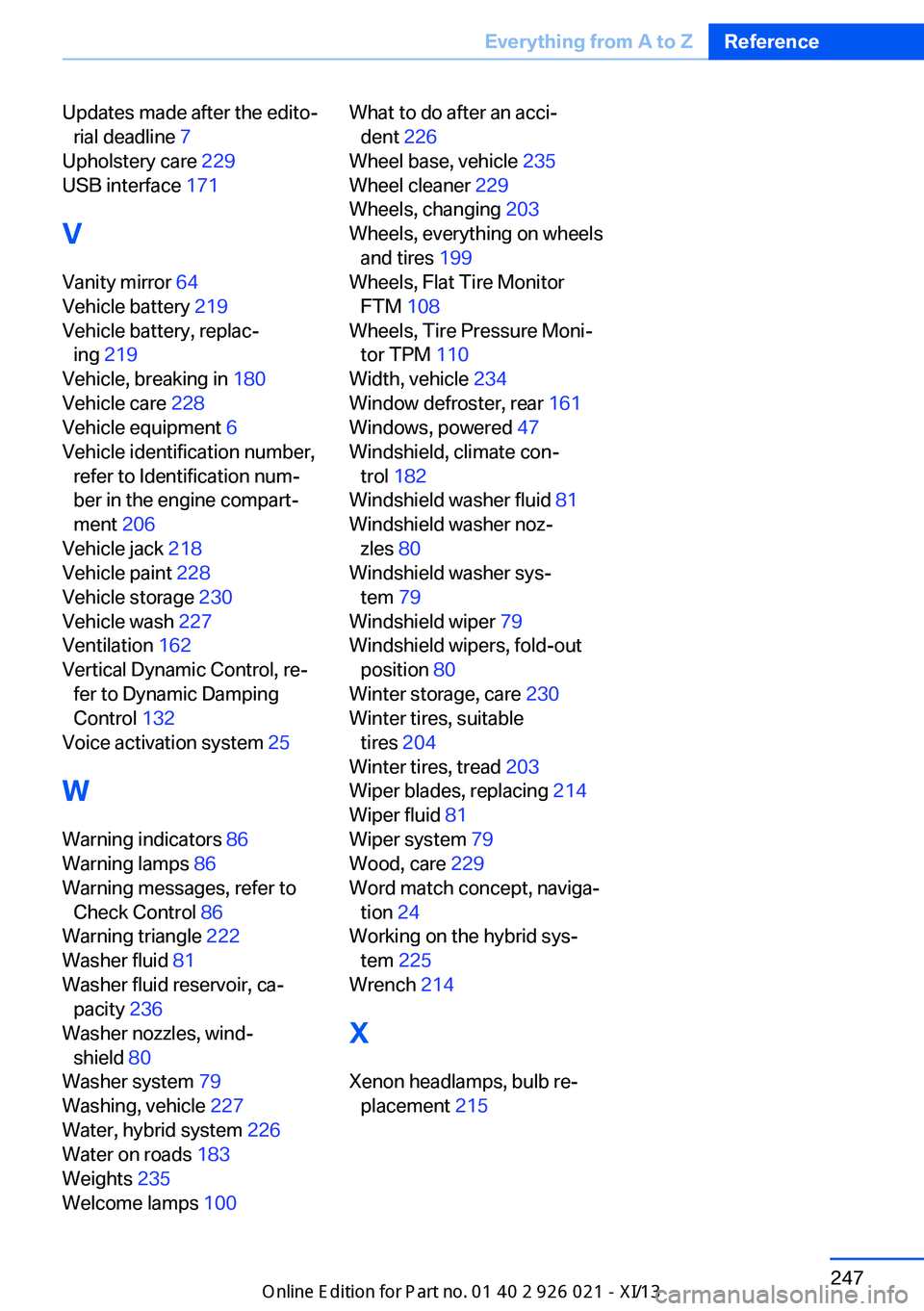
Updates made after the edito‐rial deadline 7
Upholstery care 229
USB interface 171
V
Vanity mirror 64
Vehicle battery 219
Vehicle battery, replac‐ ing 219
Vehicle, breaking in 180
Vehicle care 228
Vehicle equipment 6
Vehicle identification number, refer to Identification num‐
ber in the engine compart‐
ment 206
Vehicle jack 218
Vehicle paint 228
Vehicle storage 230
Vehicle wash 227
Ventilation 162
Vertical Dynamic Control, re‐ fer to Dynamic Damping
Control 132
Voice activation system 25
W Warning indicators 86
Warning lamps 86
Warning messages, refer to Check Control 86
Warning triangle 222
Washer fluid 81
Washer fluid reservoir, ca‐ pacity 236
Washer nozzles, wind‐ shield 80
Washer system 79
Washing, vehicle 227
Water, hybrid system 226
Water on roads 183
Weights 235
Welcome lamps 100 What to do after an acci‐
dent 226
Wheel base, vehicle 235
Wheel cleaner 229
Wheels, changing 203
Wheels, everything on wheels and tires 199
Wheels, Flat Tire Monitor FTM 108
Wheels, Tire Pressure Moni‐ tor TPM 110
Width, vehicle 234
Window defroster, rear 161
Windows, powered 47
Windshield, climate con‐ trol 182
Windshield washer fluid 81
Windshield washer noz‐ zles 80
Windshield washer sys‐ tem 79
Windshield wiper 79
Windshield wipers, fold-out position 80
Winter storage, care 230
Winter tires, suitable tires 204
Winter tires, tread 203
Wiper blades, replacing 214
Wiper fluid 81
Wiper system 79
Wood, care 229
Word match concept, naviga‐ tion 24
Working on the hybrid sys‐ tem 225
Wrench 214
X Xenon headlamps, bulb re‐ placement 215 Seite 247Everything from A to ZReference247
Online Edition for Part no. 01 40 2 909 774 - VI/13